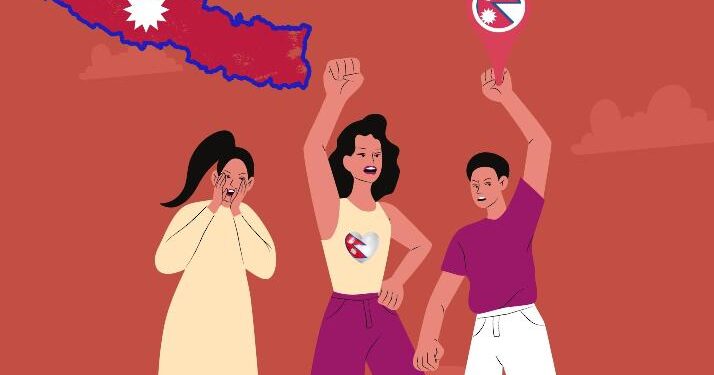Introduction
Nepal celebrates Democracy Day every year on Falgun 7th, the seventh day of the Nepali calendar. It marked the end of the dictatorship of the Rana Regime and the start of democracy in 1951. This critical event in Nepal’s history started a new era in which power shifted to the Nepali people. It laid the groundwork for the democratic government systems we have today. People honor the day by remembering the many people who gave their lives fighting for freedom and the right to choose for themselves.
In the 21st century, Democracy Day is more than just a time to remember the past. Now, people think about what democracy means to Nepal and its people today. This thought is critical when considering how Nepal’s politics, society, and economy have changed so much in recent decades. Nepal’s democracy is changing. A federal democratic republic was created, and a new constitution was written in 2015. These changes have brought both problems and solutions.

As we look into what democracy means in Nepal today, we look at how it affects government, society, and the everyday lives of Nepalis. We think about what Nepal’s democratic government has done well, what problems still need to be solved, and where it wants to go in the future. We are asked to think about how the people of Nepal live and experience democracy, how it shapes their hopes and dreams, and how it is constantly changing as a society works together to achieve justice, equality, and freedom for all.
When is Democracy Day in Nepal?
Nepal celebrates Democracy Day on Falgun 7th, an essential day in the country’s past. It marks the end of the Rana oligarchy and the start of democracy in 1951. Today is a reminder of how the people’s will won out over autocratic rule, and it shows how Nepal is moving toward freedom, equality, and fair government.
It reminds us of all the people who gave their lives fighting for the democratic rights and freedoms that many people today can easily use. When we celebrate Democracy Day, we don’t just remember the hard times we’ve been through. We also recognize our progress and the problems that still need to be solved to make society more fair and open to everyone.
Advertisement
People in Nepal do many things every year on Freedom Day to honor the memory of those who gave their lives for freedom. On this day, ceremonies, public speeches, and educational events help young people learn more about democratic ideals.
These events are very important for making people aware of the importance of following the law, being a good citizen, and being accountable to keep Nepal’s democracy healthy and strong. The spirit of democracy is brought back to life through these celebrations, encouraging people to keep talking and working together to deal with the country’s current political challenges and opportunities.
Advertisement
As we look to the future, Democracy Day makes us think about what democracy means for Nepal in the 21st century. It makes people talk about how well the democratic system works, how inclusive the government is, and how democracy can be improved to serve all of Nepali society better.
Nepal is still changing, but Democracy Day shows the country’s strength and dedication to democracy. Today is both a celebration of what has been done in the past and an inspiration to work together for a democratic future that is fair and reflective of Nepal’s diverse people.
Advertisement
Historical Context
A Concise History of Democracy in Nepal
Nepal’s path to becoming a democracy has been long and rough. Nepal began its journey toward democracy in 1951 when the Rana oligarchy was overthrown. However, this journey has been anything but straight. Once democracy was established, there were times when the government wasn’t stable. The king stepped in, and several constitutions tried to change and settle the country’s political situation.
Important things happened in the late 20th century, such as the Jana Andolan-led Popular Movement of 1990, which brought back democracy and created a multi-party system. That being said, the Comprehensive Peace Agreement in 2006, which ended a 10-year civil war and made it possible to eliminate the monarchy, was the most important event in Nepal’s recent political history. Nepal became a federal democratic republic in 2008, and a new constitution was passed in 2015 that strengthened its democracy even more by setting up a federal framework with provinces.
Advertisement
The Struggle for Democracy
Nepalese people have been strong and given up a lot in their fight for freedom. There needed to be democratic movements, especially in 1990 and 2006. These movements included large-scale protests and campaigns of civil disobedience against dictatorships.
People in Nepal became much more politically aware and involved because of these events, which significantly affected society. They restructured the government, pushed for autonomy and inclusion, and set the rules for a democratic, secular, and open Nepal. The people who fought these battles remember them and still want a democratic society that values freedom, equality, and justice.
Advertisement
Current State of Democracy
Overview of Nepal’s Current Democratic Framework
Nepal’s modern form of democracy is based on a federal parliamentary republic. Nepal’s Constitution from 2015 set up a federal system with three levels of government: the federal, the provincial, and the local. Each level has its rights and duties.
The purpose of this framework was to fix past unfairness and ensure that people of all racial, linguistic, and cultural backgrounds could be represented and have their rights. There are also fundamental rights and freedoms written into the law, which supports the democratic spirit of the country.
Achievements of Democracy in Nepal
Nepal has had democracy since its start, significantly improving government, human rights, and civil freedoms. Creating a federal structure has made it easier for a more localized and representative government to take place, leading to more involvement and accountability.
There have been significant steps forward in the laws that protect human rights, like equal rights for men and women, freedom of speech, and the rights of underrepresented groups. Elections are held regularly at all levels of government to show that democratic systems work and that people can use their right to vote.
Challenges Facing Nepalese Democracy
Nepalese democracy still has a long way to go, even with these successes. Instability in politics, shown by frequent changes in government, has slowed down long-term progress and lousy management. There is still a lot of corruption, which hurts public trust and the efficiency of service delivery.
Problems with governance, like inefficient bureaucracy and the slow pace of implementing federation, are big problems. Outside factors and geopolitical interests can also complicate internal politics and policymaking. These problems show that all parts of Nepalese society must stay alert, make changes, and be involved to improve democracy.
Democracy and Society
The Impact of Democracy on Various Aspects of Nepalese Society
Nepal’s transition to democracy has significantly affected many areas of society, especially regarding education, health care, and social equality. Democratization has made it easier to set up policies that aim to give everyone access to education and health care. This shows a commitment to making everyone’s life better. Educational reforms have aimed to raise the literacy rate and even out differences.
Advertisement
Healthcare reforms have aimed to make services more available across the country, especially in rural and neglected areas. Furthermore, democracy has been vital in supporting social equality, challenging traditional hierarchies, and fighting for the rights and inclusion of women, Dalits, and indigenous peoples, among others. These actions have been very important in making society more fair.
The Role of Youth and Civil Society in Shaping Nepalese Democracy
Civil society groups (CSOs) and young people play big roles in shaping and strengthening Nepalese democracy. A more educated and politically aware population has made young people more active in demanding openness, responsibility, and change in government.
A lot of the work that has been done to promote human rights, environmental protection, and social justice has been done by NGOs and other activist groups. Nepal’s democracy has grown stronger because these groups are involved in policy discussions and public debates. They ensure that different views are heard and considered when decisions are being made.
Reflections on Inclusivity and Representation in Nepali Politics
Nepali politics have come a long way toward being more open and inclusive, but problems still exist. The current electoral systems and federal structure were made to improve representation based on race, gender, and area. However, getting everyone to participate helpfully is still a work in progress.
Even though the law sets quotas, there still needs to be more women in political leadership roles. Ethnic and regional groups also want more freedom and respect within the federal system. These thoughts on inclusion show that we are still on the path to a more fair and representative democracy.
Democracy in the Digital Age
The Influence of Technology on Democracy in Nepal
The development of digital technology has had a big effect on Nepal’s government. Social media and online action have become essential ways to get involved in politics, raise awareness, and get people to vote. People, especially young people, can now use these technologies to voice their views, run campaigns, and hold the government accountable.
However, the digital age also needs help, especially regarding security. As more political and social activities move online, it’s become more important to protect the integrity of digital sites and the privacy and rights of users.
Challenges and Opportunities
The move to digital offers Nepalese democracy both problems and chances. Social media sites that spread false information and fake news can hurt people’s trust and make political debate unclear. Still, digital tools also make getting involved in politics and the community easier.
Researchers are looking into digital governance projects that could improve openness and service delivery, making the government more accessible for people to reach. The challenge is finding a balance between the good things about digital technologies and the bad things that can happen. This way, the digital age can help Nepal’s democratic roots rather than hurt them.
The Future of Democracy in Nepal
Public Sentiment and Aspirations for the Future of Democracy
Recent polls, conversations, and studies show that people in Nepal have a lot of different feelings about democracy. Many people are grateful for the democratic freedoms that have been gained, but they are also worried about political instability, problems with government, and economic problems.
Many people, especially young people, want a more effective, responsible, and inclusive government that can drive economic growth and ensure social justice. Nepal’s hopes for the future of democracy include a stronger and more inclusive political system where the benefits of democratic government can be seen in people’s daily lives.
The Role of International Cooperation and Support in Enhancing Nepalese Democracy
Nepal can look at several possible changes and paths to take to deal with its problems and meet the needs of its people. When it comes to politics, people could work on making the government system more stable and valuable, making party politics better, and making sure that elections are fair and transparent.
Legal reforms could strengthen the rule of law, make the courts more independent, and ensure that constitutional rights are effectively carried out. In terms of society, programs could work to reduce inequality, encourage development that includes everyone, and build a civic culture that values democratic involvement and accountability.
Along with increasing public participation and civic education, strengthening decentralization and local government are important ways to improve democratic ideals and practices.
Conclusion
Improving democracy in Nepal depends on help and partnerships from other countries. Funding, technical assistance, and programs that build people’s skills can all be used to support Nepal’s democratic structures and processes. Human rights, good government, and economic growth can all be helped by international relationships.
Thinking about Nepal’s democracy in the 21st century isn’t just a school assignment; it’s an important way to learn about the country’s success, problems, and future. Nepal’s people, policymakers, and the rest of the world must work together as its democratic systems change and adapt.
Everyone needs to support and grow the democratic institutions and ideals that make up Nepalese society. This means promoting a culture of inclusion, protecting everyone’s rights and freedoms, and working for a society that is more fair and includes everyone.
Democracies in Nepal have stood the test of time, and the country’s people’s strong character is proof of that. It is impossible to overstate how vital democracy is for future generations. It is the hope for a more fair, just, and prosperous Nepal. We hope that the democratic foundations we lay today will support the hopes and dreams of tomorrow. This will ensure that democracy stays a part of Nepal’s national character that is alive, changing, and valued.
Advertisement






